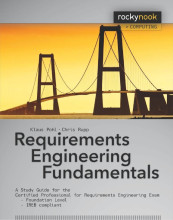Summary: Scrum Master
- This + 400k other summaries
- A unique study and practice tool
- Never study anything twice again
- Get the grades you hope for
- 100% sure, 100% understanding
Read the summary and the most important questions on Scrum Master
-
Professional Scrum Master
This is a preview. There are 61 more flashcards available for chapter 05/01/2015
Show more cards here -
Explain the usability of scrum by means of a framework
Scrum is a process framework. It is not a process or a technique for building products, rather, it is a framework within which you can employ various processes and techniques. Scrum makes clear the relative efficacy of your product management and development and development practices so that you can improve. -
What does the Scrum framework consists of?
It consists of Scrum teams and their associated roles, events, artifacts and rules. Each component serves a specific purpose and is essential to Scrums succes and usage. -
What are the goals of inspection?
Scrum users must frequently inspect Scrum artifacts and progress toward a Sprint Goal to detect undesireble variances. Their inspection should not be so frequent that inspection gets in the way of the work. Inspections are most beneficial when diligently performed by skilled inspectors at the point of work. -
How is a Scrum Team organized?
The Scrum Team consists of a Product Owner, The Development Team and a Scrum Master. Scrum Teams are self-organized. Self-organizing teams choose how best to accomplish their work, rather than being directed by others outside the team. Cross-functional teams have all competencies needed to accomplish the work without depending on others not part of the team. -
What are the goals of the design of the team model?
The team model in Scrum is designed to optimize flexibility, creativity and productivity. -
What should Scrum Teams deliver?
Scrum Teams deliver products iteratively and incrementally, maximizing opportunities for feedback. Incremental deliveries of "Done" product ensure a potentially useful version of working product is always available. -
What must be done for the Product Owner to succeed?
The Product Owner is one person, not a committee. The Product Owner may represent the desires of a committee in the Product Backlog, but those wanting to change a Product Backlog item's priority must address the Product Owner.
The entire organization must respect his or her decisions. The Product Owner's decisions are visible in the content and ordering of the Product Backlog. No one is allowed to tell the Development Team to work from a different set of requirements, and the Development Team isn't allowed to act on what anyone else says. -
What can be said about the DT size?
Optimal DT size is small enough to remain nimble and large enough to complete significant work within a Sprint. 3 to 9 Team members: >9 members requires too much coordination. Large DT's generate too much complexity for an empirical process to manage.
The Product Owner and Scrum Master roles are not included in this count unless they are also executing the work of the Sprint Backlog. -
Describe the role of the Scrum Master.
The Scrum Master is responsible for ensuring Scrum is understood and enacted. Scrum Masters do this by ensuring that the Scrum Team adheres to Scrum theory, practices and rules.
The Scrum Master is a servant-leader for the Scrum Team. The Scrum Master helps those outside the ST understand which of their interactions with the ST are helpful and which aren't. The SM helps everyone change these interactions to maximize the value created by the ST. -
What are the goals of events in Scrum?
- Prescribed events are used in Scrum to create regularity and to minimize the need for meetings not defined in Scrum.
- Other than the Sprint itself, which is a container for all other events, each event in Scrum is a formal opportunity to inspect and adapt something. These events are specifically designed to enable critical transparancy and inspection. Failure to include any of these events results in reduced transparancy and is a lost opportunity to inspect and adapt.
- Higher grades + faster learning
- Never study anything twice
- 100% sure, 100% understanding
































